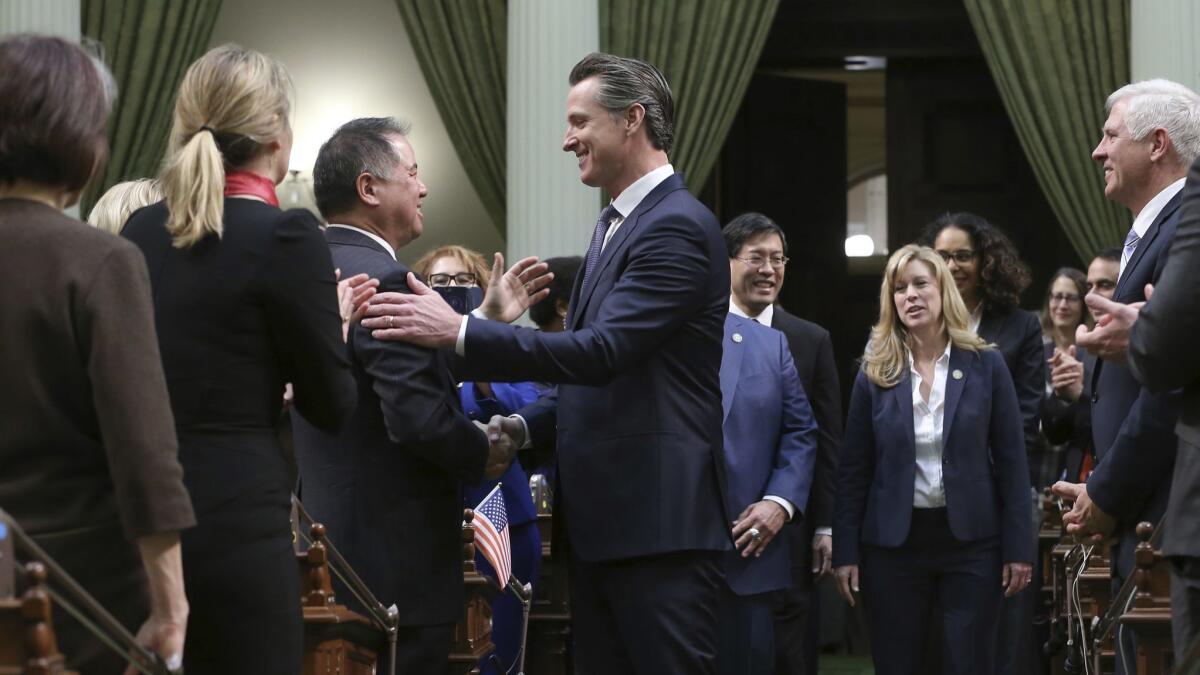Column:: California’s budget offers new help for millions — but with an expiration date

There’s long been praise for politicians who “under promise and over deliver,” a way to simultaneously temper expectations and sidestep future disappointment. But the rhetoric in Sacramento this year, in the wake of historic electoral victories last November, has rarely been that cautious.
“Let me be clear,” Gov. Gavin Newsom said just moments after taking the oath of office in January. “We will be bold. We will aim high, and we will work like hell to get there.”
The state budget Newsom is poised to sign this week has a number of provisions that look audacious — healthcare services for the poor restored almost a decade after being cut, increased provider rates for developmental disability services, grants to college students who take summer courses.
But the fine print reveals those services and others could be far more fleeting than Californians might expect. Democratic lawmakers agreed to allow as much as $873 million in new spending to disappear in a couple of years — program cuts without anyone having to cast a potentially unpopular vote in the Legislature.
Newsom first broached the idea in his budget plan last month by suggesting these targeted spending increases would automatically “sunset” — expire — at the end of the 2021 calendar year. His fiscal advisors made it clear in a series of legislative hearings over the ensuing weeks that it was simply a way to ensure state spending didn’t increase beyond projected tax revenues. Time and again, they pointed out, economists have said California is overdue for a mild or even moderate recession.
Legislative Democrats balked. But while they didn’t persuade Newsom to change his mind, they did prompt him to take a slightly different approach: Instead of simply going away, the additional government services would be “suspended” unless tax revenue estimates made two years from now show there is enough money to keep them going.
Make no mistake, though: The suspension would be a de facto cut. The decision would be left to the California Department of Finance, giving both the governor and lawmakers a bit of distance from cutting services relied on by Californians who are struggling the most.
California lawmakers quietly tuck cash for local perks inside the state’s new budget »
State leaders used some version of these automatic changes several times in recent years, a reflection of both the volatility of state tax revenues and the reluctance of elected officials to be seen as the ones responsible for wielding the budget ax. During the last recession, budgets were written with so-called “triggers” — provisions that would automatically cut spending in the event of a financial shortfall.
Former Gov. Jerry Brown used the specter of these cuts in successfully selling Proposition 30, the tax increase approved by voters in 2012. Had voters rejected the ballot measure, almost $6 billion in budget cuts would have kicked in for schools and public safety programs.
But the inclusion of a fiscal insurance policy in this year’s budget seems more notable, given that the rhetoric in 2019 has been much more emphatic. The spotlight first shone on the governor’s two-year expiration dates for some spending last month when he appeared to embrace a five-year sales tax exemption for children’s diapers and menstrual products — only to later insist it was a misunderstanding. Earlier this month, the nonpartisan Legislative Analyst’s Office recommended the tax break on menstrual products should last for up to a decade. Lawmakers, though, agreed to Newsom’s demand.
Budget watchers have praised similar efforts in Sacramento in recent years, pointing out that reassessing new spending commitments or tax exemptions is a smart way to govern. The question, though, is whether elected officials are being transparent in their embrace of that approach — or whether they’re seeking maximum credit for a minimal investment.
Follow @johnmyers on Twitter and sign up for our daily Essential Politics newsletter
More to Read
Get the L.A. Times Politics newsletter
Deeply reported insights into legislation, politics and policy from Sacramento, Washington and beyond. In your inbox three times per week.
You may occasionally receive promotional content from the Los Angeles Times.











